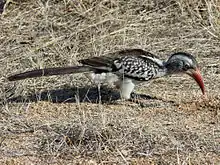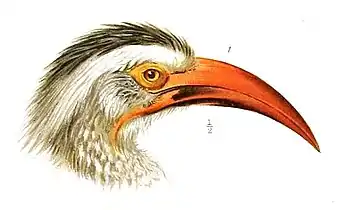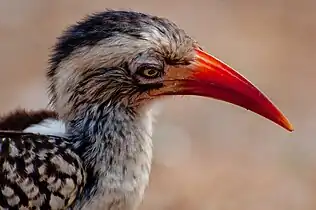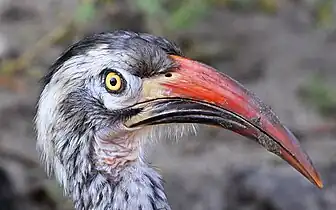Southern red-billed hornbill
The southern red-billed hornbill (Tockus rufirostris) is a species of hornbill in the family Bucerotidae, which is native to the savannas and dryer bushlands of southern Africa. It is replaced by a near-relative, the Damara red-billed hornbill, in the arid woodlands of western Namibia. All five red-billed hornbills were formerly considered conspecific.
| Southern red-billed hornbill | |
|---|---|
_male%252C_crop.jpg.webp) | |
| Male, Chobe National Park, Botswana | |
 | |
| Female in the Kruger National Park | |
| Scientific classification | |
| Domain: | Eukaryota |
| Kingdom: | Animalia |
| Phylum: | Chordata |
| Clade: | Dinosauria |
| Class: | Aves |
| Order: | Bucerotiformes |
| Family: | Bucerotidae |
| Genus: | Tockus |
| Species: | T. rufirostris |
| Binomial name | |
| Tockus rufirostris (Sundevall, 1850) | |
Subspecies
It is usually treated as a monotypic taxon, but two additional subspecies have been proposed:[1]
- Tockus rufirostris rufirostris Sundevall, 1850 — bushveld regions of Transvaal, southern Botswana and southern Zimbabwe
- Tockus rufirostris degens Clancey, 1964 — eastern lowveld
- Tockus rufirostris ngamiensis Roberts, 1932 — northern Namibia to northern Zimbabwe
T. r. degens is the smallest in size, while T. r. ngamiensis has browner plumage and a more distinct tail bar. The differences are clinal.
Description

The sexes are similar, but males are larger and heavier. Males also have somewhat longer bills, with the lower mandible coloured black to a variable extent.[1] It is distinguishable from other red-billed hornbills by the combination of yellow iris and pale orbital skin (pink to greyish), and the ample blackish plumage streaking from the ear coverts to the side of the neck. The throat is white, and the wing coverts clearly spotted.[2]
Habits
The call consists of an accelerating series notes, kuk kuk kuk ... which ends in a crescendo of double notes, kuk-we kuk-we. Unlike other red-billed hornbills, Southern red-billed hornbills do not raise their wings in display.[2]
Range
It is found from Malawi and Zambia to southern Angola, northeastern Namibia, Botswana, Zimbabwe, eastern Eswatini and northern South Africa (Transvaal and northern KZN province). It occurs in the upper Zambezi valley of Mozambique, but is mostly absent from the eastern lowlands.
Gallery
.jpg.webp) Adult male T. r. rufirostris
Adult male T. r. rufirostris Male head in profile
Male head in profile
T. r. rufirostris Head of female
Head of female
T. r. rufirostris Male head in profile
Male head in profile
T. r. ngamiensis
References
- Hockey, P. A. R.; Dean, W. R. J.; Ryan, P. G. (2005). Roberts Birds of Southern Africa (7th ed.). Cape Town: Trustees of the John Voelcker Bird Book Fund. pp. 149–151. ISBN 0-620-34053-3.
- Sinclair, Ian; Ryan, Peter (2010). Birds of Africa south of the Sahara (2nd ed.). Cape Town: Struik Nature. pp. 290–291. ISBN 9781770076235.
- Kemp, A.C. and W. Delport. 2002. Comments on the status of subspecies in the red-billed hornbill (Tockus erythrorhynchus) complex (Aves: Bucerotidae), with the description of a new taxon endemic to Tanzania. Annals of the Transvaal Museum 39: 1–8.
- Delport, W., A.C. Kemp, and J.W.H. Ferguson. 2004. Structure of an African Red-billed Hornbill (Tockus erythrorhynchus rufirostris and T. e. damarensis) hybrid zone as revealed by morphology, behavior, and breeding biology. Auk 121: 565–586.